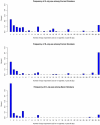How to define e-cigarette prevalence? Finding clues in the use frequency distribution
- PMID: 26085124
- PMCID: PMC4683118
- DOI: 10.1136/tobaccocontrol-2015-052236
How to define e-cigarette prevalence? Finding clues in the use frequency distribution
Abstract
Objective: E-cigarette use has rapidly increased. Recent studies define prevalence using a variety of measures; competing definitions challenge cross-study comparison. We sought to understand patterns of use by investigating the number of days out of the past 30 days when adults had used e-cigarettes.
Design: We used the 2014 Minnesota Adult Tobacco Survey, a random digit dial population survey (n=9304 adults). Questions included ever using e-cigarettes, number of days used in the past 30 days and reasons for use. Smoking status was determined by combustible cigarette use. Histograms of e-cigarette use were visually inspected for current, former and never smokers with any 30-day e-cigarette use. Different definitions of current use were compared.
Results: Use ≤5 days in the past 30 days demarcated a cluster of infrequent users at the low end of the distribution. Among those with use in the past 30 days, infrequent users were the majorities of current (59%) and never smokers (89.5%), but fewer than half of former smokers (43.2%). Infrequent users were more likely to cite curiosity and less likely to cite quitting/cutting down other tobacco use as reasons for use.
Conclusions: Defining adult prevalence as any use in the past 30 days may include experimenters unlikely to continue use, and is of questionable utility for population surveillance of public health trends over time. Defining prevalence as >5 days excludes those infrequent users.
Keywords: Co-substance use; Electronic nicotine delivery devices; Non-cigarette tobacco products; Public policy; Surveillance and monitoring.
Published by the BMJ Publishing Group Limited. For permission to use (where not already granted under a licence) please go to http://www.bmj.com/company/products-services/rights-and-licensing/
Figures
References
-
- Esterl M. ‘Vaporizers’ are the new draw in e-cigarettes. Wall Street Journal. 2014
Publication types
MeSH terms
Grants and funding
LinkOut - more resources
Full Text Sources
Other Literature Sources
Medical
Miscellaneous

